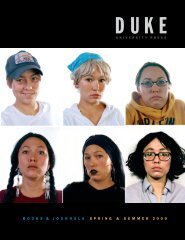Spring 2013 Catalog - Duke University Press
Spring 2013 Catalog - Duke University Press
Spring 2013 Catalog - Duke University Press
Create successful ePaper yourself
Turn your PDF publications into a flip-book with our unique Google optimized e-Paper software.
Hidden in the Mix<br />
The African American Presence in Country Music<br />
diane pecknold, editor<br />
“Hidden in the Mix is a comprehensive and worthy addition to the canon<br />
of popular music history. It breaks new ground and digs deep. By look-<br />
ing at both historical traditions (the banjo, early blues-hillbilly music) and<br />
contemporary cultural phenomena (hick-hop and country pop), as well as<br />
African American artists past and present (Bill Livers, Ray Charles, Cowboy<br />
Troy), the book greatly expands our knowledge of this intriguing subject.”<br />
—HOLLY GEORGE-WARREN, author of Public Cowboy No. 1: The Life and<br />
Times of Gene Autry<br />
Leonard Bowles and Irvin Cook, Martinsville, Virginia,<br />
1978. Photo by Peter Hartman. Courtesy of the Blue Ridge<br />
Institute & Museum of Ferrum College.<br />
Country music’s debt to<br />
African American music<br />
has long been recog-<br />
nized. Black musicians<br />
have helped to shape<br />
the styles of many<br />
of the most important<br />
performers in the<br />
country canon. The part-<br />
nership between Lesley<br />
Riddle and A. P. Carter<br />
produced much of the<br />
Carter Family’s repertoire; the street musician Tee Tot Payne taught a<br />
young Hank Williams Sr.; the guitar playing of Arnold Schultz influenced<br />
western Kentuckians, including Bill Monroe and Ike Everly. Yet attention<br />
to how these and other African Americans enriched the music played by<br />
whites has obscured the achievements of black country-music performers<br />
and the enjoyment of black listeners.<br />
The contributors to Hidden in the Mix examine how country music<br />
became “white,” how that fictive racialization has been maintained,<br />
and how African American artists and fans have used country music to<br />
elaborate their own identities. They investigate topics as diverse as the<br />
role of race in shaping old-time record catalogues, the transracial West<br />
of the hick-hopper Cowboy Troy, and the place of U.S. country music in<br />
postcolonial debates about race and resistance. Revealing how music<br />
mediates both the ideology and the lived experience of race, Hidden<br />
in the Mix challenges the status of country music as “the white man’s<br />
blues.”<br />
Contributors<br />
Michael Awkward, Erika Brady, Barbara Ching, Adam Gussow, Patrick Huber, Charles<br />
Hughes, Jeffrey A. Keith, Kip Lornell, Diane Pecknold, David Sanjek, Tony Thomas,<br />
Jerry Wever<br />
Diane Pecknold is Associate Professor of Women’s and Gender Studies at<br />
the <strong>University</strong> of Louisville. She is the author of The Selling Sound: The Rise<br />
of the Country Music Industry, also published by <strong>Duke</strong> <strong>University</strong> <strong>Press</strong>.<br />
MUSIC/AMERICAN STUDIES/AFRICAN AMERICAN STUDIES<br />
June 384 pages, 21 illustrations<br />
paper, 978–0–8223–5163–4, $27.95/£18.99<br />
cloth, 978–0–8223–5149–8, $99.95/£75.00<br />
music<br />
Living the Hiplife<br />
Celebrity and Entrepreneurship<br />
in Ghanaian Popular Music<br />
jesse weaver shipley<br />
“Jesse Weaver Shipley has written a highly compelling account of hiplife<br />
in Ghana. Historically and ethnographically rich, it demonstrates how this<br />
musical form has affected ideas of Ghanaian identity. Not only does hiplife<br />
celebrate entrepreneurship among African youth situated in the ‘shadows’<br />
of the global order. It also provides them with a language of mobile signs<br />
‘geared toward capitalist accumulation and consumption.’ Based on a broad<br />
range of theoretical sources, Shipley’s writing is lively, his insights memorable.<br />
This is a book that anyone interested in Africa, anyone interested in<br />
contemporary cultural production, will want to read.”—JOHN COMAROFF,<br />
Harvard <strong>University</strong> and the American Bar Foundation<br />
Hiplife is a popular music genre in<br />
Ghana that mixes hip-hop beatmaking<br />
and rap with highlife music, proverbial<br />
speech, and Akan storytelling. In<br />
the 1990s, young Ghanaian musicians<br />
were drawn to hip-hop’s dual ethos<br />
of black masculine empowerment and<br />
capitalist success. They made their<br />
underground sound mainstream by<br />
infusing carefree bravado with traditional<br />
respectful oratory and familiar<br />
Ghanaian rhythms. Living the Hiplife<br />
is an ethnographic account of hiplife<br />
in Ghana and its diaspora, based<br />
on extensive research among artists and audiences in Accra, Ghana’s<br />
capital city; New York; and London. Jesse Weaver Shipley examines the<br />
production, consumption, and circulation of hiplife music, culture, and<br />
fashion in relation to broader cultural and political shifts in neoliberalizing<br />
Ghana.<br />
Shipley shows how young hiplife musicians produce and transform<br />
different kinds of value—aesthetic, moral, linguistic, economic—using<br />
music to gain social status and wealth, and to become respectable<br />
public figures. In this entrepreneurial age, youth use celebrity as a<br />
form of currency, aligning music-making with self-making and aesthetic<br />
pleasure with business success. Registering both the globalization of<br />
electronic, digital media and the changing nature of African diasporic<br />
relations to Africa, hiplife links collective Pan-Africanist visions with<br />
individualist aspiration, highlighting the potential and limits of social<br />
mobility for African youth.<br />
Jesse Weaver Shipley is Associate Professor of Anthropology at<br />
Haverford College.<br />
ANTHROPOLOGY/AFRICAN STUDIES/POPULAR MUSIC<br />
February 352 pages, 54 illustrations (including 9 in color)<br />
paper, 978–0–8223–5366–9, $24.95/£16.99<br />
cloth, 978–0–8223–5352–2, $89.95/£67.00<br />
27












